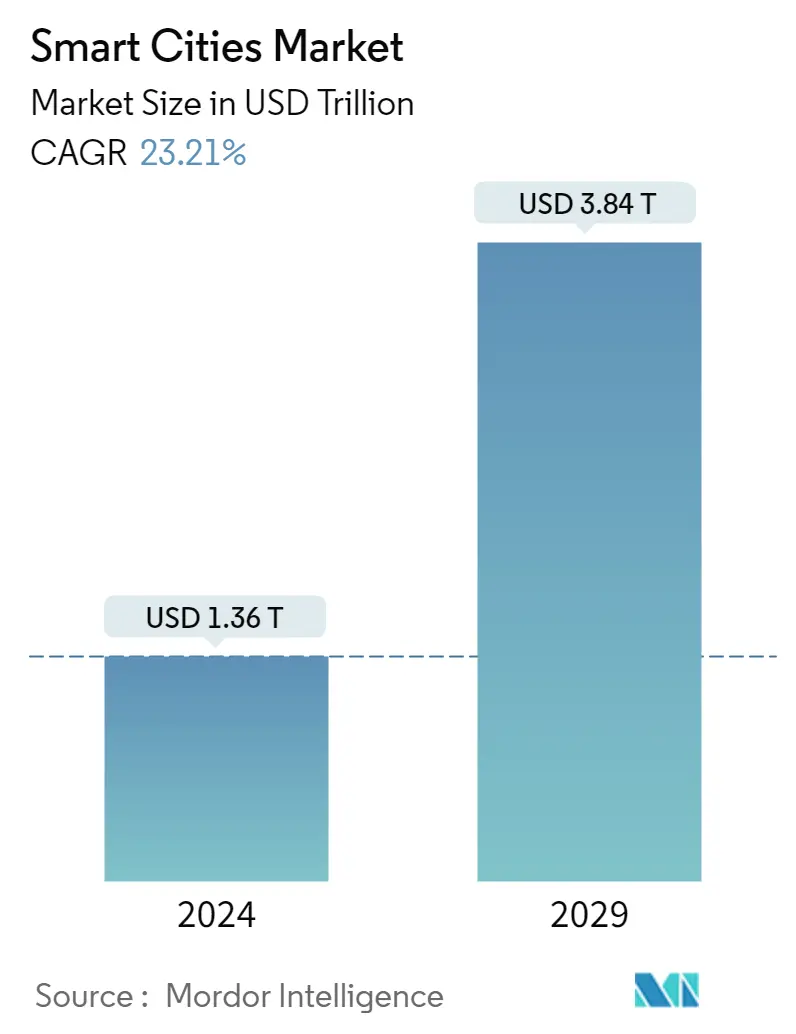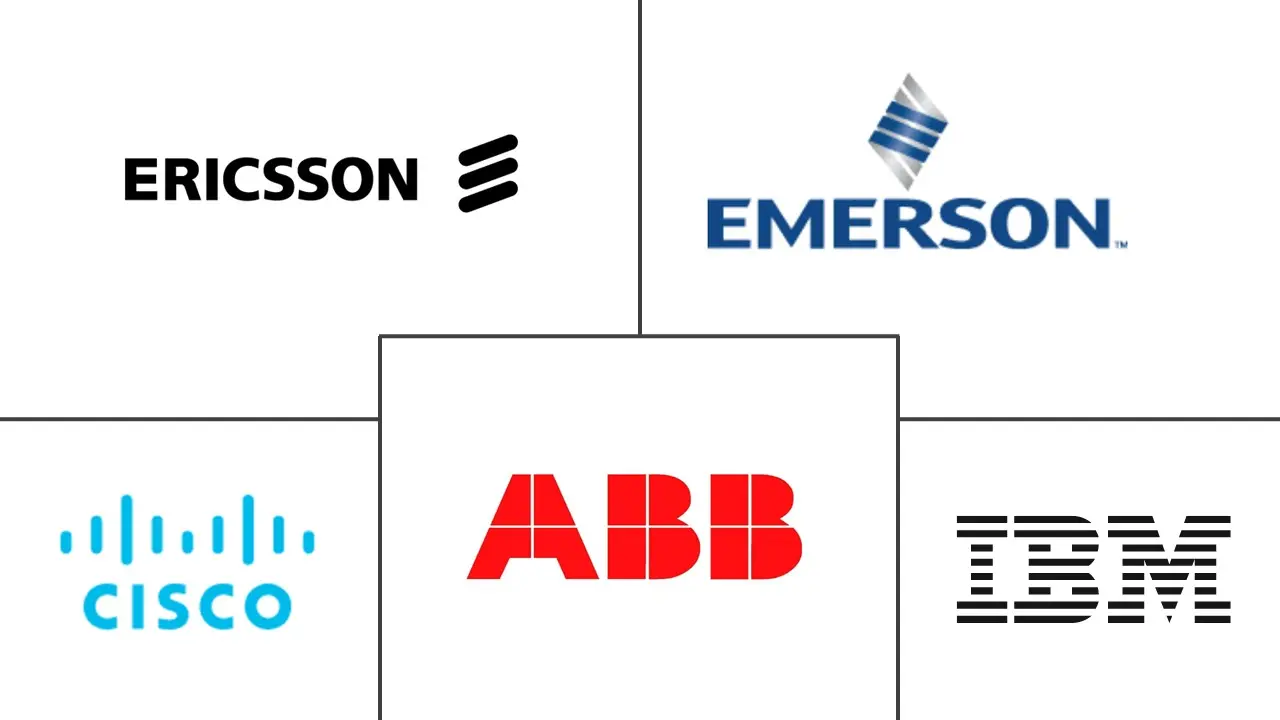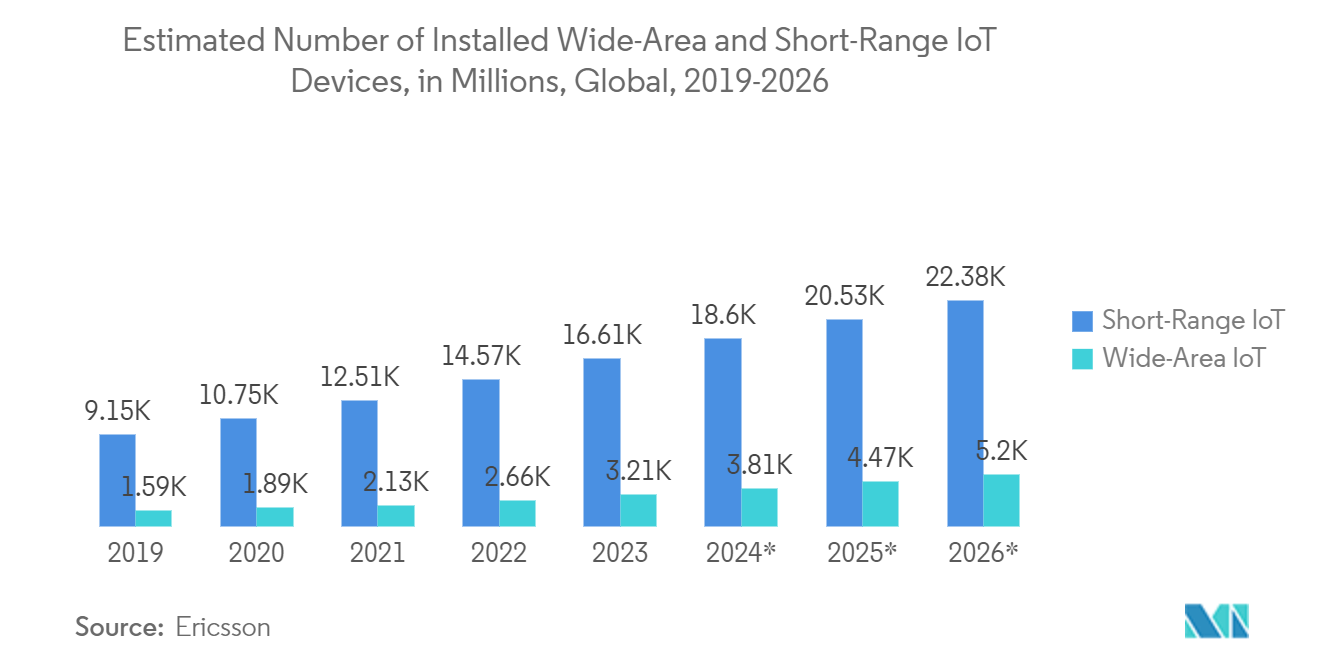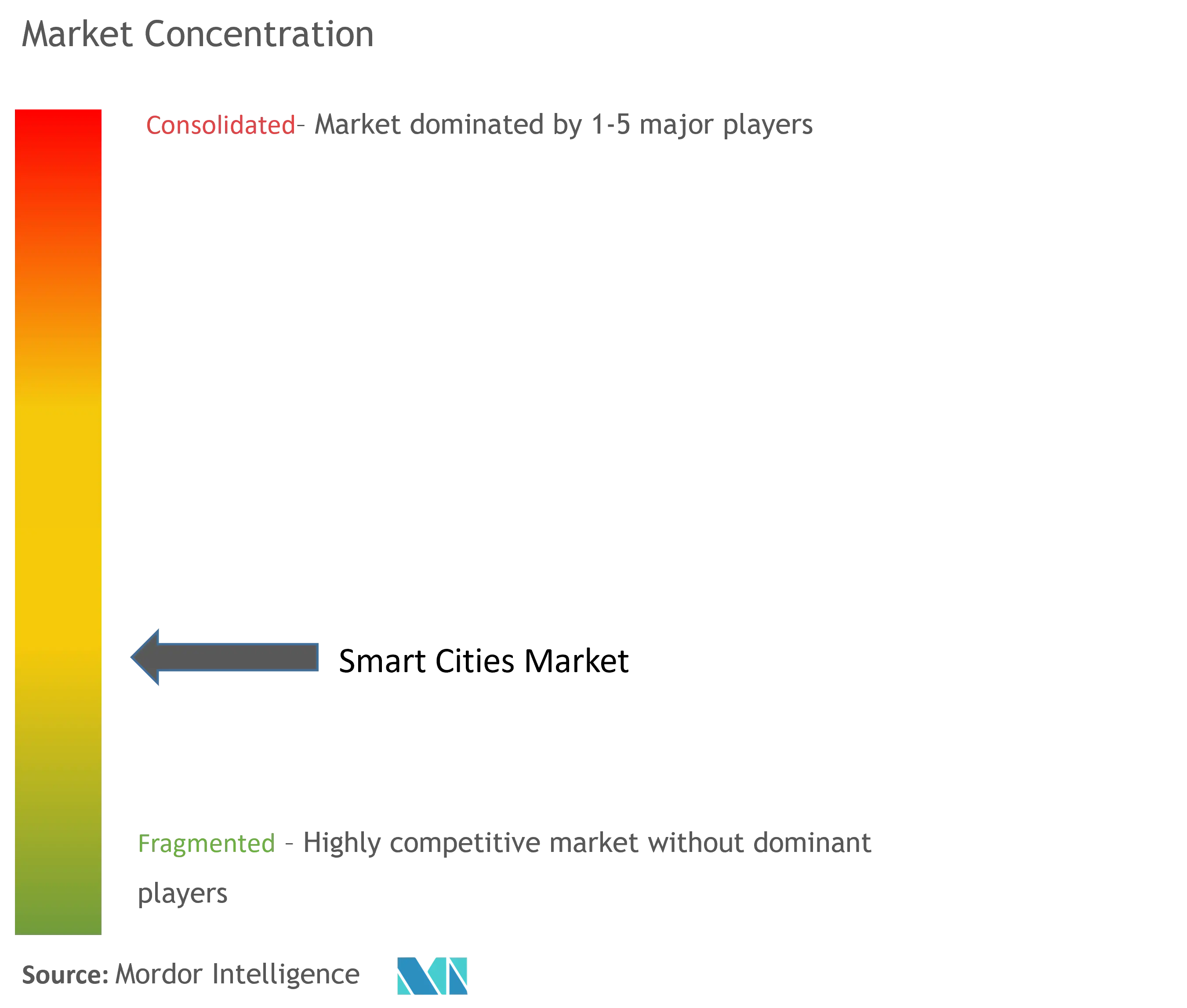Smart Cities Market Size

| Study Period | 2019 - 2029 |
| Market Size (2024) | USD 1.36 Trillion |
| Market Size (2029) | USD 3.84 Trillion |
| CAGR (2024 - 2029) | 23.21 % |
| Fastest Growing Market | Asia-Pacific |
| Largest Market | Europe |
Major Players
*Disclaimer: Major Players sorted in no particular order |
Smart Cities Market Analysis
The Smart Cities Market size is estimated at USD 1.36 trillion in 2024, and is expected to reach USD 3.84 trillion by 2029, growing at a CAGR of 23.21% during the forecast period (2024-2029).
The market numbers in the study indicate the revenue generated from various types of solutions such as smart mobility management, smart public safety, smart healthcare, smart building, smart utilities, smart security, smart education, and other solutions.
- A smart city is an urban area that makes use of cutting-edge technologies such as artificial intelligence (AI), the Internet of Things (IoT), cloud storage, big data, and data analytics to gather and analyze utilization data and use the insights gained from them to manage resources, services, and assets effectively. Growing government measures to address urbanization and overpopulation and the growing need for resource management for sustainable development are driving growth in the smart cities industry.
- The increased adoption of the Internet and the Internet of Things propel the growth of smart cities and platforms worldwide. It is expected that by the next three years, there will be more than 26 smart cities, with the majority existing in North America and Europe, providing a major drive to the AI and IoT sensors for adoption in smart cities.
- From the first telegraphic fire alarms to radios and dash cams, public safety agencies-law enforcement, fire, EMS, and emergency management-have always been early adopters of the newest technologies. Increasing smart device networks and the development of artificial intelligence are turning public safety technology today from a necessary toolkit into an independent partner that can take action to keep the public safe.
- Various organizations in the studied market are focusing on strategic partnerships, investments, and expansion to help countries adopt smart solutions. For instance, in October 2022, Nokia announced a strategic partnership with Nedaa, the security network provider of the Dubai government, to explore innovative 5G network slicing for public safety use and smart cities. Similarly, in October 2022, Siemens AG announced to invest EUR 5 billion ( USD 5.41 billion) in India to support the country's rapid urbanization and energy transformation.
- Moreover, in February 2023, Companies from Singapore and Asia Pacific, such as Daily Life Renewable Energy, Mdesigns Solutions, Biodsg, and Graymatics, among others, will collaborate with United Arab Emirates (UAE) firms to develop smart city pilot projects in Abu Dhabi. These companies will collaborate with local entities such as Adnoc and the rest to develop resilient cities by transforming street lighting and increasing the energy efficiency of Al Dannah City buildings.
- Data security is the prime concern of every government incorporating the smart city plan, as it is vital in industries such as BFSI, retail, healthcare, and others, owing to the sensitive nature of the data. IoT platforms used for smart cities are experiencing high adoption rates due to IoT demand. This increasing use of these platforms for smart cities across various verticals has increased the vulnerabilities of these systems to data breaches. The need for a uniform security platform is increasing, with many providers offering multiple solutions.
- COVID-19 propelled the development of smart cities. Smart city infrastructure helped government agencies avoid the dangerous COVID-19 virus. Post-COVID-19, the government has also been investigating the potential for implementing some smart city technologies to increase urban resilience in times of crisis. The government of Singapore has acknowledged the significance of accelerating the nation's degree of digitization across industries.
Smart Cities Market Trends
Adoption of AI and IoT to be Major Drivers for the Market
- The increased adoption of the Internet and the Internet of Things propel the growth of smart cities and platforms worldwide. It is expected that by 2025, there will be more than 26 smart cities, with the majority existing in North America and Europe, providing a major drive to the AI and IoT sensors for adoption in smart cities.
- The use of IoT has increased, from industrial applications to emergency services, public transportation, public safety, city lighting, and smart city applications. Municipalities are moving to wireless communications offered by IoT due to low cost, greater efficiency, and resource reduction. According to Cisco, machine-to-machine (M2M) connections supporting IoT applications will account for over half of the world's 28.5 billion connected devices by 2022. Connections from smart speakers, fixtures, devices, and associated devices will reach 14.6 billion, and the connected home vertical will account for the bulk of total M2M connections.
- Furthermore, local governments in other parts are investing in smart and adaptive streetlights to improve energy efficiency. For instance, Chicago has launched a smart lighting program that aims to install 270,000 LED lights over four years. During the project's initial year, the city installed 81,000 LED lights. Chicago estimates it will save around USD 10 million yearly in utility costs. The project includes a monitoring and control system that immediately alerts the city of any outages. It also allows workers to optimize the performance of the streetlights.
- As part of the Digital India initiative, the Indian government has planned to push IoT in the country. The government allocated INR 7,000 crore ( USD 84.52 billion) for the development of 100 smart cities powered by IoT devices to control traffic, efficiently use water and power, and collect data using IoT sensors for healthcare and other services.
- With smart city initiatives, the trend of increasing IoT and connected devices is expected to continue over the forecast period. The growing adoption of connected devices that include smart meters, smart homes, smart lighting, and smart transportation, among others that use IoT to connect, is likely to propel the growth of smart city platforms.
- As of January 2022, the state of Uttar Pradesh in India had the smartest meters installed nationwide, with over 1.15 million of them. Bihar and Rajasthan are ranked after this. Similarly, according to the Energy Information Administration, About 111 million advanced (smart) metering infrastructure (AMI) installations, or 69% of all electric meter installations, were made by U.S. electric utilities in 2021. About 88% of all AMI installations were for residential customers, and AMI meters made up about 69% of all residential electric meters.
- Moreover, the leading players in the market are focusing on introducing IoT and AI-based solutions to stay ahead of the competition, further supporting the market growth. For instance, in March 2022, Hitachi announced the launch of a full-scale Smart Building Solution business for Southeast Asia and Thailand. The company aims to provide value to buildings with Physical Security Systems and Digital Services for the New Normal by utilizing Lumada, an IoT Platform. Lumada is Hitachi's advanced digital services, solutions, and technologies for turning data into valuable knowledge to drive digital innovation.

Asia-Pacific is Expected to be the Fastest Growing Market
- Asia-Pacific is one of the fastest-growing regions for innovative city technologies, with China playing a significant role in the market growth. China has made significant investments in the digital transformation of its cities. With its top-down approach to urban development, the country has effectively mobilized its industries and resources to support its national aim of constructing smart cities. China has built smart city infrastructure that has already been applied to many of its main metropolises and sectors through public-private partnerships and the promotion of focused technical innovation.
- A few firms have taken the lead in the transformation of cities as new technologies emerge after decades of research and development. Alibaba, Baidu, Didi Chuxing, Huawei, and Tencent are among those that have integrated their technology in cities such as Hangzhou, Suzhou, Shenzhen, Shanghai, and Beijing. These technologies then serve as the foundation for "digital brains," which use cloud computing, AI, and IoT to lay the groundwork for smart city infrastructure.
- The Japanese government has been supporting the Society 5.0 concept to achieve Sustainable Development Goals by realizing a smart society that provides people with a better quality of life by tightly connecting the internet and physical space. The Japanese government's Strategic Innovation Promotion Program (SIP) has been instrumental in the development of collaboration infrastructure in each field, such as agriculture and transportation infrastructure, as well as the development of inter-field data collaboration infrastructure to connect them, and the formulation of the Smart City Reference Architecture as a basic design guideline for smart cities.
- Government policies and collaborations towards the development of cities are expected to drive the studied market. For Instance, The India Urban Data Exchange was created in collaboration with the Smart Cities Mission and the Indian Institute of Science (IISc) in Bengaluru. IUDX provides a unified interface for data suppliers and users, including ULBs, to share, request, and access datasets relating to cities, urban government, and urban service delivery. IUDX is an open-source software platform that enables secure, authenticated, and managed data exchange between different data platforms, third-party certified and authorized apps, and other sources. As the number of cities on IUDX grows, this would lead to uniform and frictionless data sharing between data producers and consumers throughout urban India.
- The Green Building Council of Australia (GBCA) has revealed the government's Smart Cities Plan, which should increase investment performance and seek to improve the country's sustainability factor. This new plan would make significant adjustments to the existing finances. To begin, it would coordinate and drive smarter city policies. This is done to ensure that both local and national governments are on board with the projected changes. Furthermore, it would endeavor to establish clear models for infrastructure, innovation, and sustainability inside city bounds.
- Furthermore, Several companies are making investments and expansions to support the smart city development in the region. For instance, in March 2023, Honeywell International announced the launch of phase one of the Banglore Safe City Project. Through this project, the company aims to secure an efficient, safe, and empowering environment for girls and women through its smart and connected safety and security technology. The company will likely install more than 7,000 video cameras at more than 3,000 strategic locations within Bengaluru. These cameras are equipped with artificial intelligence (AI) enabled systems. The AI-based video analytics platform will allow for the analysis of video feeds from across the city.
- Similarly, in January 2023, Tech Mahindra and Tagawa City in Japan announced a strategic collaboration to accelerate digital transformation in the city. Tech Mahindra will help Tagawa become a smart city. Through this collaboration, Tech Mahindra will enhance its expertise in next-generation technologies such as IoT, 5G, virtual reality, and augmented reality.

Smart Cities Industry Overview
The smart cities market is semi-consolidated during the forecast period. The major players in the market are ABB Ltd, Cisco Systems Inc., Emerson Electric Co., IBM Corporation, and Ericsson Inc. Players in the market are adopting strategies such as partnerships, innovations, investments, and acquisitions to enhance their product offerings and gain sustainable competitive advantage.
In June 2023, ABB announced the acquisition of Eve Systems, a Munich-based leader in smart home products with operations in the United States and Europe, to strengthen its smart home technology portfolio. Through this acquisition, the company aims to meet the accelerating demand for smart, safe, and sustainable retrofitting of buildings driven by energy prices and climate policies.
In June 2023, Siemens AG announced the opening of Egypt's first Smart Cities Experience Centre to offer customers an immersive experience that combines the digital and real worlds. The center will showcase the latest technologies for creating efficient and sustainable smart city infrastructure, buildings, and industries. Through this concept, visitors can understand the benefits of transforming current communities into smart cities.
Smart Cities Market Leaders
-
ABB Ltd
-
Cisco Systems Inc.
-
Emerson Electric Co.
-
IBM Corporation
-
Ericsson Inc.
*Disclaimer: Major Players sorted in no particular order

Smart Cities Market News
- June 2023: TIM, a telecom operator, and Ericsson announced an increase in their investments in private networks and IoT projects in Brazil. TIM has announced various new projects, particularly in smart cities/public lighting. In the previous month, the company announced a smart lighting project in Porto Alegre, Rio Grande do Sul state, using 4G NB-IoT technology for IPSul, the concessionaire responsible for public lighting in the city.
- November 2022: Emerson Electric Co. announced the completion of the USD 3-billion sale of its InSinkErator business to Whirlpool Corporation. InSinkErator was founded in 1938 and acquired by Emerson in 1968. It manufactured food waste disposers and instant hot water dispensers for home and commercial use. Whirlpool Corporation, a home appliance industry leader, is well-positioned to capitalize on InSinkErator's substantial legacy and performance to achieve long-term growth and success.
Smart Cities Market Report - Table of Contents
1. INTRODUCTION
- 1.1 Study Assumptions and Market Definition
- 1.2 Scope of the Study
2. RESEARCH METHODOLOGY
3. EXECUTIVE SUMMARY
4. MARKET INSIGHTS
- 4.1 Market Overview
- 4.2 Industry Value Chain Analysis
-
4.3 Industry Attractiveness - Porter's Five Forces Analysis
- 4.3.1 Bargaining Power of Suppliers
- 4.3.2 Bargaining Power of Buyers
- 4.3.3 Threat of New Entrants
- 4.3.4 Threat of Substitutes
- 4.3.5 Intensity of Competitive Rivalry
5. MARKET DYNAMICS
-
5.1 Market Drivers
- 5.1.1 Rising Adoption of AI and IoT
- 5.1.2 Growth in the need for public safety and security
-
5.2 Market Challenges
- 5.2.1 Security Concerns Related to IoT and Smart Devices
- 5.3 Impact of COVID-19 on the Smart Cities Market
6. MARKET SEGMENTATION
-
6.1 By Solution
- 6.1.1 Smart Mobility Management
- 6.1.2 Smart Public Safety
- 6.1.3 Smart Healthcare
- 6.1.4 Smart Building
- 6.1.5 Smart Utilities
- 6.1.6 Smart Security
- 6.1.7 Smart Education
- 6.1.8 Other Solutions
-
6.2 By Geography
- 6.2.1 North America
- 6.2.1.1 United States
- 6.2.1.2 Canada
- 6.2.2 Europe
- 6.2.2.1 United Kingdom
- 6.2.2.2 Germany
- 6.2.2.3 France
- 6.2.2.4 Sweden
- 6.2.2.5 Rest of Europe
- 6.2.3 Asia-Pacific
- 6.2.3.1 China
- 6.2.3.2 Japan
- 6.2.3.3 India
- 6.2.3.4 Australia
- 6.2.3.5 South Korea
- 6.2.3.6 Rest of Asia-Pacific
- 6.2.4 Latin America
- 6.2.4.1 Mexico
- 6.2.4.2 Brazil
- 6.2.4.3 Argentina
- 6.2.4.4 Rest of Latin America
- 6.2.5 Middle East and Africa
- 6.2.5.1 Saudi Arabia
- 6.2.5.2 United Arab Emirates
- 6.2.5.3 South Africa
- 6.2.5.4 Rest of Middle East and Africa
7. COMPETITIVE LANDSCAPE
-
7.1 Company Profiles*
- 7.1.1 ABB Ltd.
- 7.1.2 Cisco Systems Inc.
- 7.1.3 Emerson Electric Co.
- 7.1.4 IBM Corporation
- 7.1.5 Ericsson Inc.
- 7.1.6 Schneider Electric SE
- 7.1.7 General Electric Co.
- 7.1.8 Siemens AG
- 7.1.9 Huawei Technologies Co. Ltd.
- 7.1.10 Honeywell International Inc.
- 7.1.11 Hitachi Ltd.
- 7.1.12 Nokia Corporation
- 7.1.13 Koninklijke Philips NV
8. INVESTMENT ANALYSIS
9. FUTURE OF THE MARKET
** Subject To AvailablitySmart Cities Industry Segmentation
A smart city is an urban area that uses different types of electronic methods and sensors to collect data. Insights gained from that data are used to manage assets, resources, and services efficiently. This data is used to improve operations across the city.
The smart city market report is segmented by solution (smart mobility management, smart public safety, smart healthcare, smart building, smart utilities, smart security, smart education) and by geography (North America, Europe, Asia-Pacific, Latin America, Middle East and Africa). The market sizes and forecasts are provided in terms of value (USD) for all the above segments.
| By Solution | Smart Mobility Management | |
| Smart Public Safety | ||
| Smart Healthcare | ||
| Smart Building | ||
| Smart Utilities | ||
| Smart Security | ||
| Smart Education | ||
| Other Solutions | ||
| By Geography | North America | United States |
| Canada | ||
| By Geography | Europe | United Kingdom |
| Germany | ||
| France | ||
| Sweden | ||
| Rest of Europe | ||
| By Geography | Asia-Pacific | China |
| Japan | ||
| India | ||
| Australia | ||
| South Korea | ||
| Rest of Asia-Pacific | ||
| By Geography | Latin America | Mexico |
| Brazil | ||
| Argentina | ||
| Rest of Latin America | ||
| By Geography | Middle East and Africa | Saudi Arabia |
| United Arab Emirates | ||
| South Africa | ||
| Rest of Middle East and Africa |
Smart Cities Market Research FAQs
How big is the Smart Cities Market?
The Smart Cities Market size is expected to reach USD 1.36 trillion in 2024 and grow at a CAGR of 23.21% to reach USD 3.84 trillion by 2029.
What is the current Smart Cities Market size?
In 2024, the Smart Cities Market size is expected to reach USD 1.36 trillion.
Who are the key players in Smart Cities Market?
ABB Ltd, Cisco Systems Inc., Emerson Electric Co., IBM Corporation and Ericsson Inc. are the major companies operating in the Smart Cities Market.
Which is the fastest growing region in Smart Cities Market?
Asia-Pacific is estimated to grow at the highest CAGR over the forecast period (2024-2029).
Which region has the biggest share in Smart Cities Market?
In 2024, the Europe accounts for the largest market share in Smart Cities Market.
What years does this Smart Cities Market cover, and what was the market size in 2023?
In 2023, the Smart Cities Market size was estimated at USD 1.04 trillion. The report covers the Smart Cities Market historical market size for years: 2019, 2020, 2021, 2022 and 2023. The report also forecasts the Smart Cities Market size for years: 2024, 2025, 2026, 2027, 2028 and 2029.
What factors are driving the growth of the Smart Cities Market?
The growth of the Smart Cities Market is driven by: a) Increasing urbanization b) Need for resource management c) Advancement in innovative technologies like Internet of Things, Artificial Intelligence, and big data analytics d) Rising awareness of the benefits of smart cities
What role does IoT play in Smart Cities Market?
The Internet of Things (IoT) is crucial for data collection and analysis, enabling real-time responses in urban management, from traffic control to environmental monitoring and public safety.
Smart Cities Industry Report
The Smart City Market Report is segmented by solution, including smart mobility management, smart public safety, smart healthcare, smart building, smart utilities, smart security, and smart education. Geographically, it covers North America, Europe, Asia-Pacific, Latin America, and the Middle East and Africa. The market sizes and forecasts are provided in terms of value (USD) for all the mentioned segments.
The global landscape of smart cities is experiencing a transformative phase, highlighted by rapid adoption of technologies like Artificial Intelligence (AI), Internet of Things (IoT), and 5G. This growth is driven by a focus on public safety, efficient resource management, and environmental sustainability. Smart city trends such as intelligent infrastructure, smart energy solutions, and innovative public safety measures are pivotal.
The smart cities growth narrative is supported by statistics showing market share, size, and revenue growth rates. Government initiatives and strategic collaborations, particularly in North America and Asia-Pacific, play a significant role. This evolution towards sustainable urban living leverages technology to improve life quality.
The report includes a market analysis and market research, providing insights into market value and growth rate. Market leaders are identified, and market segmentation is detailed. The global market overview offers a comprehensive market forecast and market trends. An annual report and growth statistics are included, along with an industry overview and market outlook. The market report provides market statistics and market share information.
The detailed market forecast outlook and historical overview are available in a free report PDF download. The industry analysis includes industry information, industry outlook, industry reports, and industry research. Industry sales, industry size, industry statistics, and industry trends are also covered. Market data, market predictions, market review, and market segmentation are discussed. The report example and research companies are provided for further reference.



